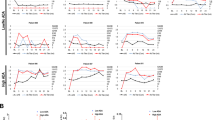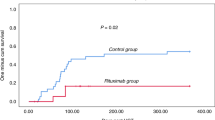Abstract
Hurler Syndrome is corrected by allogeneic BMT by the action of donor enzyme on recipient tissue. In this paper, we describe monitoring of 39 patients transplanted in two centres to determine donor chimerism, enzyme level and residual substrate – expressed as dermatan sulphate to chondroitin sulphate ratio. We show that in fully engrafted recipients, the enzyme level, expressed as μmol/g total protein/h, post-transplant is 24.2 from an unrelated donor and 10.2 from a heterozygote family donor (P<0.0001). There is a tight relationship between mean post-transplant enzyme level and residual substrate – Spearman's rank correlation coefficient (Rho) was −0.76 and −0.80 at 12 and 24 months, respectively (P<0.0001). We propose that these differences affect patient outcome. As unrelated donor transplant outcomes improve and especially given the higher levels of donor cell engraftment following cord transplants, our data might influence donor selection where only heterozygote-matched family members are available.
This is a preview of subscription content, access via your institution
Access options
Subscribe to this journal
Receive 12 print issues and online access
$259.00 per year
only $21.58 per issue
Buy this article
- Purchase on Springer Link
- Instant access to full article PDF
Prices may be subject to local taxes which are calculated during checkout




Similar content being viewed by others
References
Neufeld EF, Muenzer J . The Mucopolysaccharidoses. McGraw-Hill: New York, 2001, pp 3421–3452.
Fratantoni JC, Hall CW, Neufeld EF . Hurler and Hunter syndromes: mutual correction of the defect in cultured fibroblasts. Science 1968; 162: 570–572.
Wraith JE, Clarke LA, Beck M, Kolodny EH, Pastores GM, Muenzer J et al. Enzyme replacement therapy for mucopolysaccharidosis I: a randomized, double-blinded, placebo-controlled, multinational study of recombinant human alpha-L-iduronidase (laronidase). J Pediatr 2004; 144: 581–588.
Peters C, Steward CG . Hematopoietic cell transplantation for inherited metabolic diseases: an overview of outcomes and practice guidelines. Bone Marrow Transplant 2003; 31: 229–239.
Vellodi A, Young EP, Cooper A, Wraith JE, Winchester B, Meaney C et al. Bone marrow transplantation for mucopolysaccharidosis type I: experience of two British centres. Arch Dis Child 1997; 76: 92–99.
Peters C, Shapiro EG, Anderson J, Henslee-Downey PJ, Klemperer MR, Cowan MJ et al. Hurler syndrome: II. Outcome of HLA-genotypically identical sibling and HLA-haploidentical related donor bone marrow transplantation in fifty-four children. The Storage Disease Collaborative Study Group. Blood 1998; 91: 2601–2608.
Peters C, Balthazor M, Shapiro EG, King RJ, Kollman C, Hegland JD et al. Outcome of unrelated donor bone marrow transplantation in 40 children with Hurler syndrome. Blood 1996; 87: 4894–4902.
Boelens JJ, Wynn RF, O'Meara A, Veys P, Cavazzana-Calvo M, Wulfraat N . Results of Haemopoietic Stem Cell Transplantation for Hurler Syndrome: European Experience 1994–2004. ASH 2005. 2005, abstract 402, p 121a.
Stirling JL, Robinson D, Fensom AH, Benson PF, Baker JE . Fluorimetric assay for prenatal detection of Hurler and Scheie homozygotes or heterozygotes. Lancet 1978; 1: 147.
Whiteman P . Prenatal diagnosis of mucopolysaccharidoses. Lancet 1973; 1: 1249.
Boerwinkle E, Xiong WJ, Fourest E, Chan L . Rapid typing of tandemly repeated hypervariable loci by the polymerase chain reaction: application to the apolipoprotein B 3′ hypervariable region. Proc Natl Acad Sci USA 1989; 86: 212–216.
Staba SL, Escolar ML, Poe M, Kim Y, Martin PL, Szabolcs P et al. Cord-blood transplants from unrelated donors in patients with Hurler's syndrome. New Engl J Med 2004; 350: 1960–1969.
Grewal SS, Krivit W, Defor TE, Shapiro EG, Orchard PJ, Abel SL et al. Outcome of second hematopoietic cell transplantation in Hurler syndrome. Bone Marrow Transplant 2002; 29: 491–496.
Author information
Authors and Affiliations
Corresponding author
Rights and permissions
About this article
Cite this article
Church, H., Tylee, K., Cooper, A. et al. Biochemical monitoring after haemopoietic stem cell transplant for Hurler syndrome (MPSIH): implications for functional outcome after transplant in metabolic disease. Bone Marrow Transplant 39, 207–210 (2007). https://doi.org/10.1038/sj.bmt.1705569
Received:
Revised:
Accepted:
Published:
Issue Date:
DOI: https://doi.org/10.1038/sj.bmt.1705569
Keywords
This article is cited by
-
B-cell depletion abrogates immune mediated cytopenia and rejection of cord blood transplantation in Hurler syndrome
Bone Marrow Transplantation (2022)
-
Cell therapy for diverse central nervous system disorders: inherited metabolic diseases and autism
Pediatric Research (2018)
-
Elevated cerebral spinal fluid biomarkers in children with mucopolysaccharidosis I-H
Scientific Reports (2016)
-
Sleep disordered breathing in mucopolysaccharidosis I: a multivariate analysis of patient, therapeutic and metabolic correlators modifying long term clinical outcome
Orphanet Journal of Rare Diseases (2015)
-
Plasma and urinary levels of dermatan sulfate and heparan sulfate derived disaccharides after long‐term enzyme replacement therapy (ERT) in MPS I: correlation with the timing of ERT and with total urinary excretion of glycosaminoglycans
Journal of Inherited Metabolic Disease (2013)



